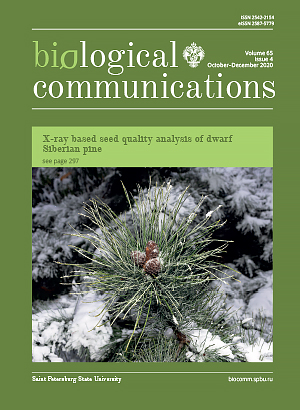Estimation of the frost resistance of the strawberry
DOI:
https://doi.org/10.21638/spbu03.2020.402Abstract
As a result of the experiment, it was found that an increase in bound water and a decrease in free water in the leaves in the autumn are characteristic of strawberry plants against the background of a decrease in the level of total water content. The maximum ratio of bound water to free water based on the accumulation of sucrose and the amino acid proline was established in such varieties as ‘Solovushka’, ‘Tsaritsa’, ‘Sara’ and ‘Korona’. A high level of correlation was noted between the minimum air temperature and physiological and biochemical indicators of the formation of frost resistance of strawberries. A high correlation was established between the degree of freezing tolerance of strawberry plants and the fractional composition of water at the beginning of winter. In the early winter, the frost-resistant strawberry varieties ‘Solovushka’, ‘Rosinka’, ‘Tsaritsa’, ‘Korona’ and ‘Sara’ were characterized. The ability to stably maintain frost resistance during the winter thaw was shown by the varieties ‘Solovushka’, ‘Tsaritsa’ and ‘Korona’. As a result of the studies, frost-resistant strawberry varieties — ‘Solovushka’, ‘Tsaritsa’ and ‘Korona’ — were isolated.
Keywords:
strawberry, varieties, fractional composition of leaf water, sucrose, proline, artificial freezing, frost resistance
Downloads
References
Downloads
Published
How to Cite
License
Articles of Biological Communications are open access distributed under the terms of the License Agreement with Saint Petersburg State University, which permits to the authors unrestricted distribution and self-archiving free of charge.





